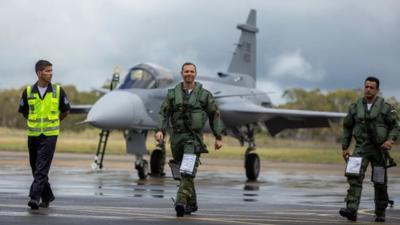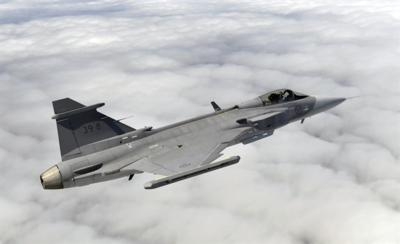“Affordable” Fighter Has a Rough Go Taking on American Fighter Sales
Colombia formally announced its intent to procure the Saab Gripen E/F in April, after a very long will-they-won’t-they process.

Colombia’s been debating a Gripen buy since 2011, drawn out by threats of American vetos over the use of the GE F414G engine, among other issues. The deal is great news for the Gripen program, which has apparently been trundling along without a foreign sale for more than a decade, despite Sweden’s eagerness and support to move some metal abroad. The deal with Colombia will be financed by Swedish government loans, netting the country 16 new aircraft to the eyewatering tune of about $228 million apiece. Those who remember the Gripen’s early development process should intuit quickly why that number seems, in a word, bonkers–The Gripen was meant to be an affordable aircraft above all else, using as much off-the-shelf equipment as possible. That mystique of being an affordable Gen-4 fighter for the rest of the world was further bolstered by some slick marketing by Saab, purporting to show that there was a non-U.S. design that could round all the 21st century multi-role bases without
breaking the bank.
But the Gripen’s costs have been thoroughly trounced by American offerings, offering aircraft of similar capability on both sides of its pricepoint. Looking at older Gripen deals, one can come up with the Brazilian deal from 2014, where they paid about $5.5 billion for 36 aircraft. That deal brought domestic production into it, which alters costs to an extent, but overall it can be napkin-mathed as $150 million or so for each plane. Add a decade of inflation and the Colombian price of $228 million starts to come into focus…

But even at 2014 prices per the Brazil contract, a $150 million Gripen looks way too expensive compared to a brand-new Block 70 F-16V, running around $70 million fully outfitted. That number is quite negotiable too, depending on loadout, but pad it out at 10, even 20 percent on top of that and the F-16 still looks like a steal. But the Falcon has always been a very hard plane to beat in the market, drafted to be a VFR dayfighter aimed at cheap mass production. Designed to flood the skies of the Soviet-U.S. Ragnarok, the F-16 grew out of its barebones youth with decades of performance improvements to keep up with the rest of the world. It is after all, a -Victor model today. A few more years and the F-16 program will have to wrap back around at the top of the alphabet again! The real surprising competitor is the F-35 program, which is apparently–shockingly–demanding a fraction of the Gripen’s costs somewhere from $80 to $100 million.
If anything, it’s a true testament to the unfathomable power behind the U.S. military industrial ecosystem that the shoestring budget fighter (whether that image is accurate or not) has been completely eclipsed by aircraft above and below its capability. Sure, the F-35 program’s
accounting is an abyss of government mystery, and is equal parts jobs-program and diplomatic fetter, but those shopping with the brochures laid out on the table see a 5th generation fighter for “half” the cost of a Gripen. Generally, one would see the Gripen as a good fit for cost-conscious governments that don’t want American sway on their deployments, as can happen when Uncle Sam’s blessing is needed for continued airworthiness. But the Gripen uses American engines,making the point somewhat moot.
Where the Gripen still has an edge is the apparent cost-per-hour in actual service. Colombia may have run the numbers themselves and come to the opposite conclusion that Finland & Sweden did when they bought the F-35: Sure, it’s more expensive upfront, but each Gripen-hour costs a third of the F-35’s (ballpark it at $8,000 versus $35,000 or so) so it all comes out in the wash. The Czechs, operators of more than a dozen Gripens, once cited a flight hour cost of even less than that, around $4,500 in 2020, meaning the Gripen could be cheaper per hour than some of the stuff on the NBAA-BACE show floor! But, the complex arithmetic that goes into procurement cuts every which way on the timeline, too. A lease extension offer from Sweden recently put a price tag of $732 million on support and sustainment of 12 Gripens out to 2035, necessary for the Czechs to complete the changeover to the F-35. That in itself is telling, in a sense: Even an ardent Gripen customer is jumping ship to Uncle
Sam’s houseboat so they can enjoy a half-century of 5th generation performance with the rest of the cool kids.
 ANN's Daily Aero-Linx (05.06.25)
ANN's Daily Aero-Linx (05.06.25) ANN's Daily Aero-Term (05.06.25): Ultrahigh Frequency (UHF)
ANN's Daily Aero-Term (05.06.25): Ultrahigh Frequency (UHF) ANN FAQ: Q&A 101
ANN FAQ: Q&A 101 Classic Aero-TV: Virtual Reality Painting--PPG Leverages Technology for Training
Classic Aero-TV: Virtual Reality Painting--PPG Leverages Technology for Training Airborne 05.02.25: Joby Crewed Milestone, Diamond Club, Canadian Pilot Insurance
Airborne 05.02.25: Joby Crewed Milestone, Diamond Club, Canadian Pilot Insurance




